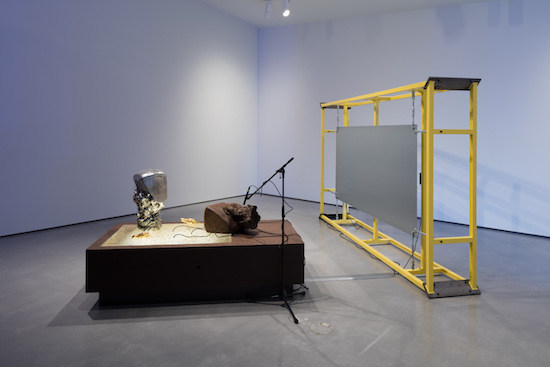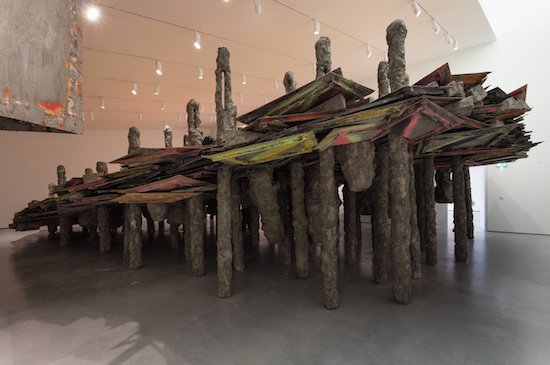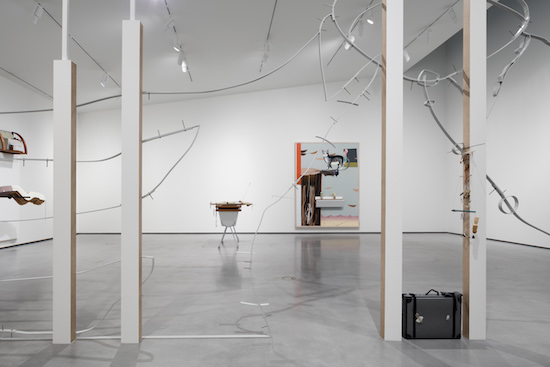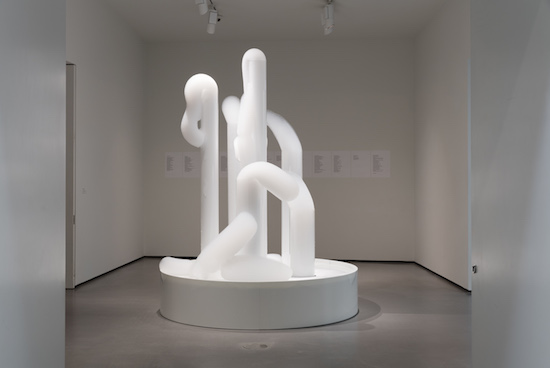David Medalla’s ‘Cloud Canyons’, 1964 – 2016, ©The Artist, courtesy The Hepworth Wakefield; Photo: Lewis Ronald
If you could trace any broad direction in culture this century, you might argue that the boundaries that delineate genre across all mediums have become increasingly porous, or simply meaningless. Now that the internet allows us to jump instantly between decades and across borders, the distinctions between performance art and conceptual art, say, or electronic music and folk, appear less as useful waymarkers and more as obstructive barriers. A strange time then for the five-year-old Hepworth Wakefield to launch a new prize with such a concrete remit. The biannual award of £30,000 is solely for sculpture, and unlike the Turner with its bizarre age cap, the only rule is that the artist has to be British or based here. There’s also a People’s Choice award, with a public vote running until the show closes on 19 February.
A new prize for one discipline makes sense when you look at the work of the four nominated artists, arrived at from a long-list of 25 and each invited to submit work from across their careers. Together they stretch the definition of ‘sculpture’ to breaking point. They’re as far as you can get from the oblique bronze form of Barbara Hepworth’s Ascending Form (Gloria), sat on a plinth outside a Wakefield shopping centre a mile from the gallery. Unlike the modernist certainty of Hepworth’s cast bronze, Phyllida Barlow’s screestage is frail and makeshift and if you put it in the open air it’d probably fall apart.
The installation sees the veteran artist combine sculpture and architecture, filling a room with a ramshackle structure built from plywood boards and other flimsy materials, its sheer scale used as a kind of artistic blunt force. Built to fit the site, Barlow turns the Hepworth’s high ceilings and naturally lit rooms to her advantage. Galleries often block out the sunlight from their adopted homes but not at the purpose-built Hepworth, where David Chipperfield’s generous floor-to-ceiling windows allow daylight to flood Barlow’s work, the changing light significantly altering the feel of the piece throughout the day. Built at an angle sloping from ground level towards the ceiling, Barlow allows us to explore beneath her nomadic shelter if we’re careful, a cramped and claustrophobic experience, especially if you’re over six foot. Suspended above her plywood palace is a rat king’s tail of black wires.
Barlow has carefully placed the plywood boards to give the illusion of them having been thrown together at random, like debris piled up in the aftermath of a disaster. Chief curator Andrew Bonacina explained that she exhibited another version of the piece in Des Moines, and although she de-constructed it and rebuilt it in a different shape to fit the smaller Hepworth space, she used exactly the same number of boards, raising questions about the assumed permanency of architectural forms.
Helen Marten bolsters her paintings with sculptural elements while her sculptures look like paintings. In the middle of her space is the huge White Cotton is so platonic, or something, a 2D line drawing rendered in steel. Her wall-mounted canvases have clusters of objects fixed to them like a Robert Rauschenberg, but rather than the American’s pop culture collages Marten’s imagery is more enigmatic, such as her recurring motif of a cat walking on its own tail. It looks straight at us, its eyes following us round the room. Her work is the hardest to decipher of the four, and the enjoyment in it comes from its pure form. Bonacina told me that people often assume Marten’s sculptural work consists solely of readymades – found objects put to a new purpose – but that most are actually created in her studio.

Steven Claydon, Re-dextinction Table and Transmission Assembly, 2016, © The Artist, courtesy The Hepworth Wakefield; Photo: Lewis Ronald
I love that specific genre of sculpture where artists use the techniques and processes of high-end product design to create objects that have no practical purpose. Objects that use the overly familiar design language of James Dyson, Terence Conran and Jony Ive but for no end gain, forcing us to consider and admire design not just as a means to an end. Marten’s Bluebutter Idles, a sort of boutique cherry wood cot for an alien baby, does this perfectly.
Yes, Marten is the artist that Michael Gove recently described as producing #modishcrap after she won the Turner, though he seemingly didn’t think her important enough to bother spelling her name right. She’s an odd choice of scapegoat for contemporary art as her work doesn’t go in for the shock value of the Chapmans or engage in what a former culture minister called “cold conceptual bullshit”. Instead it’s playful, nuanced and easy to like, with the range of everyday found objects she uses (cherry stones, cigarette butts) counterbalancing the glossy render and stainless steel of her studio work. All of her pieces have the levity of line drawings.

Installation view of Phyllida Barlow’s exhibition, © The Artist, courtesy The Hepworth Wakefield; Photo: Lewis Ronald
Blurring boundaries between performance art and sculpture is David Medalla’s approach, who has recreated two works dating from the sixties. A Stitch In Time allows visitors to sew any item they like onto suspended fabric, with contributions ranging from train and bus tickets (dozens of these actually) to photographs, crisp packets and, spookily, a cutting from a local paper with the headline “Mystery surrounds head’s resignation.” A few enterprising entrepreneurs have added business cards or flyers. My friend Nick sewed his shopping list on a few weeks ago but I couldn’t find it. It’s as absorbing as it sounds and it’s hard not to scan the entire thing, though I’m a bit cynical about a work subject to a public vote that also invites the public to join in.
Medalla’s other submission is Cloud Canyons, an ‘auto-creative sculpture’ with plastic tubes generating foam in gradually changing shapes. The pace of it – the visual art equivalent of slow TV – is what makes it engaging, even if it isn’t the revelation it would have been in 1961. It’s slightly unfortunate that a work designed to celebrate kinetic movement in nature is in competition with Chipperfield’s windows, which offer a mesmerising view of the fast-flowing weir of the River Calder running right up against the gallery’s concrete ramparts. The weir should have been short listed for the competition.
Steven Claydon’s room is the most traditionally sculptural, even if it’s a world entered through yellow PVC curtains like you’d find in an abattoir, subtly scented with citrus (nice touch, that). I liked the pair of bearded busts turned upside down with wires attached to them, like they were in intensive care. Although other writers seem to have likened them to Grecian marbles, I immediately thought of the endless statues of Marx and Lenin littered all over the provincial USSR. Like at the Momento Park outside Budapest the heads have seemingly been dumped, no longer of use. One had a microphone held over its mouth, as if these once-venerated ideologues were being asked if they had anything left to say.

Installation view of Helen Marten’s exhibition, © The Artist, courtesy The Hepworth Wakefield; Photo: Lewis Ronald
Three of the four shortlisted artists are over forty. All over the cultural cosmos the cult of youth which has reigned supreme since the nineties shows signs of being toppled, with 2016’s best music coming from Collins, Cohen and Bowie. Still, it was 31-year-old Helen Marten who actually won the Hepworth Prize, and the hypnotic curiosity she inspires in viewers as well as her ever expanding mantelpiece of awards suggests that we might see another British sculptor join the behemoths of Hepworth and Moore. Props to her too for splitting the £30k between all four artists. The gallery also has plans for its own future, with Bonacina telling me that over the next ten years they’re looking to refurbish and expand into the redbrick Victorian warehouses to the south of Chipperfield’s fortress. Before leaving I voted for Barlow. She’s been building similarly ramshackle structures for fifty years but at the tail end of 2016 they felt more relevant than ever. Standing under screestage is to feel acute unease, as if the sky is falling in and we’re running out of options.
The Hepworth Prize for Sculpture is at the Hepworth, Wakefield, until 19 January


